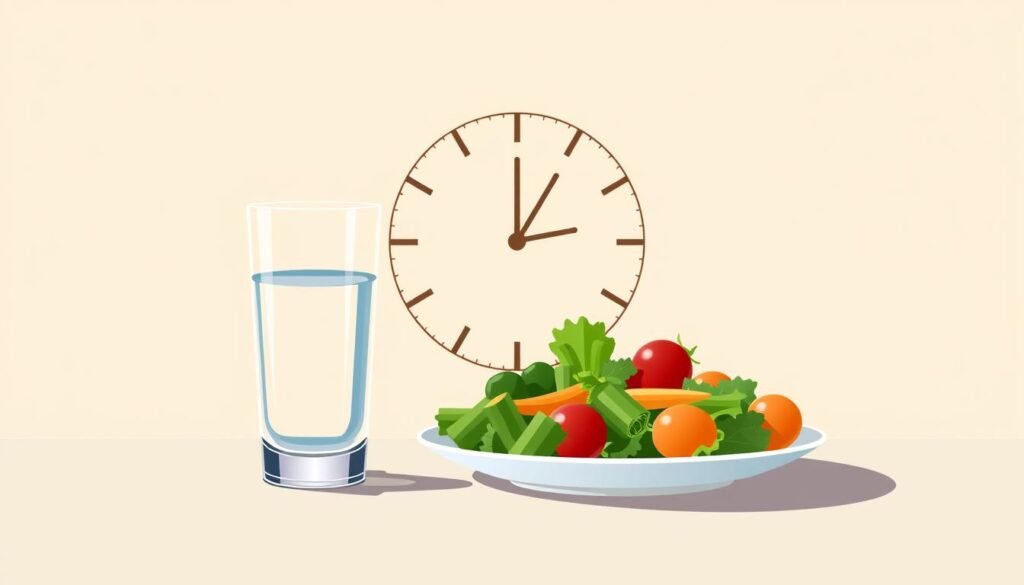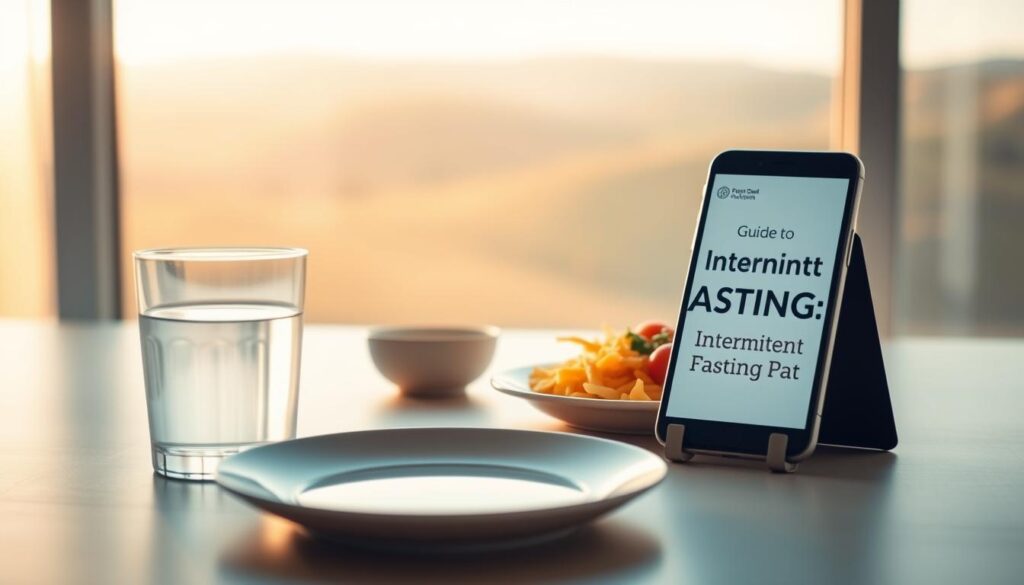Did you know 40% of Americans have tried intermittent fasting in the past year? It’s not just another diet trend. It’s a lifestyle change that can transform your health and wellness.
If you’re curious about starting intermittent fasting, you’re in the right spot. This guide will cover everything you need to know to start your health journey. It’s great for losing weight, improving metabolic health, or boosting energy.
Starting with intermittent fasting is easy. It’s about finding a healthy eating pattern that fits your life. By learning the basics and using simple strategies, you can unlock amazing benefits for your body and mind.
Key Takeaways
- Intermittent fasting is a flexible approach to nutrition
- Multiple fasting methods exist for different lifestyles
- Health benefits extend beyond weight loss
- Start slowly and listen to your body
- Consistency is key to seeing results
- Consult with a healthcare professional before starting
Understanding the Basics of Intermittent Fasting
Intermittent fasting is more than just dieting. It’s about when you eat, not what. It involves alternating between eating and fasting. This unique pattern changes how your body works.

Does intermittent fasting work? Yes, it can help with weight and health. Your body goes through important changes when fasting:
- Cellular repair processes activate
- Insulin levels drop significantly
- Human growth hormone increases
- Gene expression shifts toward longevity
Exploring Fasting Windows
There are many fasting windows to fit different lives. Here’s a quick look at some popular ones:
| Fasting Method | Fasting Period | Eating Window |
|---|---|---|
| 16/8 Method | 16 hours | 8 hours |
| 5:2 Diet | 2 low-calorie days | 5 normal eating days |
| Eat-Stop-Eat | 24-hour fast, 1-2 times/week | Normal eating other days |
The Metabolic Science of Fasting
Intermittent fasting changes your body in amazing ways. It makes your body use fat for energy instead of glucose. This can help you manage weight and boost energy.
Finding the right fasting plan is key. Everyone’s body is different. So, be patient and keep going on your fasting journey.
Health Benefits That Make Intermittent Fasting Worth Trying

Intermittent fasting is a powerful way to boost your health and lose weight. It’s more than just cutting calories. It’s a complete method to change your body and improve your well-being.
Your body goes through amazing changes when you fast. Fasting helps your body burn fat better, improves how it uses insulin, lowers inflammation, and repairs cells.
When you fast, your body becomes more efficient at using energy. It starts to burn stored fat more effectively. This helps you lose weight without losing muscle.
Some key benefits include:
- Weight Management: Helps you eat fewer calories naturally
- Metabolic Health: Keeps blood sugar levels in check
- Brain Function: May improve how well your brain works
- Longevity: Could help your cells repair themselves
Keep in mind, everyone’s results are different. Always talk to a doctor before starting any new diet. They can make sure it’s right for you.
A Simple Guide to Getting Started and Seeing Results
Starting intermittent fasting can seem daunting. But, it’s not hard to learn how to do it right. Begin by understanding your body and finding a fasting plan that fits your life.

When you start fasting, focus on creating a plan that feels doable. Be patient and flexible as you make this change.
Creating Your Personal Fasting Schedule
Creating a fasting schedule that fits your day is key. Follow these steps:
- Look at how you eat now
- Pick a fasting method that suits you
- Begin with short fasts and get longer
- Pay attention to how your body feels and adjust
Setting Realistic Goals
Setting goals for fasting is important. Remember, everyone’s progress is different. Your goals might be:
- Boosting metabolic health
- Controlling weight
- Getting more energy
- Improving overall health
Tracking Your Progress
Keeping track of your journey helps stay motivated. Track:
- Your energy levels
- How hungry you feel
- How well you sleep
- Changes in your body
- How clear your mind is
By starting with a thoughtful plan, you’ll be more likely to succeed and make lasting changes.
The 16/8 Method: Most Popular Fasting Schedule for Beginners
The 16/8 plan is great for beginners wanting to change their health habits. It’s simple and fits well into most daily routines. You fast for 16 hours and eat in an 8-hour window each day.
Here’s how the 16/8 method typically works:
- Choose an 8-hour eating window that suits your schedule
- Fast for the remaining 16 hours of the day
- Drink water, tea, or black coffee during fasting hours
- Maintain a balanced diet during your eating window
For example, you might eat between 12 pm and 8 pm, then fast from 8 pm to 12 pm the next day. This method is easy for beginners because it fits with natural eating times. It doesn’t require big changes in your diet.
The 16/8 method has many benefits for newbies. It can improve insulin sensitivity, boost metabolism, and help with weight management. Many find it easier to stick to than other fasting methods, making it a great start for your health journey.
Pro tip: Start gradually and listen to your body as you adapt to this new eating pattern.
Remember, consistency is key for beginners. Your body will take time to get used to the fasting schedule. Be patient and stay hydrated during this process.
What to Eat (and Avoid) During Your Eating Window
Choosing the right foods during intermittent fasting can be hard. Your eating window is key for keeping your body healthy and your energy up. The right foods can greatly help your fasting journey.
When you break your fast, your body wants gentle, nutrient-rich foods. These foods help with recovery and digestion. Here are some top picks for breaking your fast:
- Lean proteins like grilled chicken or fish
- Soft-cooked eggs
- Smoothies with leafy greens
- Fermented foods like yogurt
- Bone broth
Foods That Support Your Fasting Goals
To eat healthy while fasting, choose whole, unprocessed foods. These foods give you the most nutrients. Your meals should include:
| Food Category | Recommended Options | Benefits |
|---|---|---|
| Proteins | Salmon, tofu, lean meats | Muscle maintenance, satiety |
| Complex Carbohydrates | Sweet potatoes, quinoa, brown rice | Sustained energy, fiber |
| Healthy Fats | Avocados, nuts, olive oil | Hormone balance, nutrient absorption |
Hydration Guidelines
Drinking enough water is very important during fasting. Drink water, herbal tea, and electrolyte-rich drinks. Try to drink at least 8-10 glasses a day to help your metabolism and avoid dehydration.
*”Nutrition is not about being perfect. It’s about eating food that makes you feel great.”* – Unknown
Remember, everyone’s body is different. Pay attention to how your body reacts and adjust your diet as needed.
Common Challenges and How to Overcome Them
Starting intermittent fasting can feel overwhelming. Many people face similar obstacles that can stop their progress. Knowing these common mistakes in intermittent fasting can help you stay on track and reach your health goals.
Hunger is often the biggest challenge for beginners. To avoid hunger during fasting, try these strategies:
- Drink plenty of water throughout your fasting window
- Consume low-calorie beverages like black coffee or herbal tea
- Plan your eating window to include nutrient-dense meals
- Get enough sleep to reduce hunger triggers
Social situations can make it hard to stick to intermittent fasting. Prepare ahead of time by telling friends and family about your eating schedule. Here are some tips for handling social events:
- Choose flexible fasting windows that fit your lifestyle
- Be open about your fasting schedule
- Bring your own healthy snacks to gatherings
- Focus on socializing, not just eating
Mental preparation is key to successful intermittent fasting. Set realistic goals and track your progress. Remember, occasional slip-ups are normal. What’s important is your overall commitment to the process.
“Consistency is key in intermittent fasting. Small, sustainable changes create lasting results.”
By anticipating challenges and using practical strategies, you’ll be better at keeping up with your intermittent fasting routine. This will help you achieve your wellness goals.
Combining Exercise with Intermittent Fasting
Adding exercise to your fasting routine can really boost your metabolism and fitness. It’s important to know how to train your body for fasting and keep up with your workout plan. This is key for beginners aiming to reach their health goals.
Your body reacts differently to exercise when fasting. A good beginner-friendly fasting routine needs careful planning. This ensures you support your fitness goals without losing energy.
Best Workout Times While Fasting
- Morning workouts during fasting window can help accelerate fat burning
- Late afternoon exercise works well for maintaining muscle mass
- Listen to your body and adjust timing based on personal energy levels
“The key is finding a rhythm that works for your unique metabolism and fitness goals.” – Nutrition Experts
Exercise Intensity Guidelines
When you’re boosting your metabolism with fasting, consider these exercise intensity tips:
- Start with low to moderate intensity workouts
- Gradually increase exercise duration and intensity
- Prioritize strength training and low-impact cardio
Pro tip: Hydration is critical during fasted workouts. Drink water and consider electrolyte supplements to maintain energy levels.
Remember, everyone’s body reacts differently to fasting and exercise. Listen to your body’s signals and adjust your plan as needed.
Managing Hunger and Staying Motivated
Starting intermittent fasting can be tough, even for beginners. The secret to success is finding smart ways to handle hunger and keep your motivation up. This is key to making it through your fasting journey.
For beginners, it’s important to know how to feel full while fasting. Mental preparation is a big part of your success. Here are some tips to help you stay motivated:
- Practice mindfulness meditation to distract from hunger pangs
- Drink plenty of water during fasting windows
- Plan engaging activities during low-energy periods
- Create a supportive environment that encourages your fasting goals
Staying hydrated is key when fasting. Here are some tips for staying hydrated:
| Hydration Technique | Benefits |
|---|---|
| Drink herbal tea | Suppresses appetite, provides warmth |
| Consume electrolyte water | Maintains energy levels, reduces fatigue |
| Drink cold water | Boosts metabolism, reduces hunger sensation |
Remember, your body adapts to new eating patterns over time. Be patient with yourself and celebrate small victories along the way.
“Consistency is more important than perfection in your intermittent fasting journey.”
Your mindset plays a big role in your fasting experience. Imagine your health goals, track your progress, and adjust your fasting schedule as needed. This will help you find what works best for your body.
How to Track Your Fasting Results
Tracking your intermittent fasting journey is more than just watching the scale. It helps you see the big picture of your health and wellness improvements.
As a beginner, tracking your progress is key. It takes patience and smart tracking to see results from fasting.
Essential Progress Monitoring Tools
Use these tools to follow your fasting journey:
- Smartphone apps like Zero and FastHabit
- Digital fitness trackers
- Personal wellness journals
- Weekly body measurement logs
Success Metrics Beyond Weight
Weight loss is important, but it’s not all. Track these key areas too:
- Energy levels throughout the day
- Sleep quality and duration
- Mental clarity and focus
- Emotional well-being
- Digestive health
Remember, everyone’s fasting journey is different. Some see changes in weeks, others in months. Stay consistent, track your progress, and celebrate every small win.
Building Sustainable Fasting Habits
Turning intermittent fasting into a lasting lifestyle needs careful planning and dedication. Success in long-term fasting comes from a flexible plan that fits your life and routine.
To make fasting a habit, try these helpful tips:
- Start with a fasting schedule that fits your life
- Slowly increase fasting time to feel comfortable
- Plan your meals ahead to save time and effort
- Surround yourself with people who support your fasting goals
For beginners, focus on being consistent, not perfect. Remember, it’s okay to slip up sometimes. It doesn’t ruin your whole journey. Pay attention to your body and adjust your fasting plan as needed.
| Habit Building Strategy | Implementation Tips |
|---|---|
| Mindset Preparation | Practice self-compassion and view fasting as a wellness journey |
| Tracking Progress | Use apps or journals to monitor your fasting experience |
| Social Support | Connect with like-minded individuals or online communities |
Building lasting habits takes time and understanding. Your fasting practice should improve your life, not add stress. Stay adaptable, listen to your body, and celebrate your small wins.
Safety Tips and Warning Signs to Watch For
Intermittent fasting can be great for health, but it’s important to know how to start safely. Your body reacts differently to fasting, so it’s key to watch for warning signs to stay healthy.
When you’re new to intermittent fasting, there are a few things to keep in mind:
- Keep an eye on your energy levels
- Watch for persistent fatigue or weakness
- Be alert to significant mood changes
- Track your nutritional intake
When to Adjust Your Fasting Schedule
It’s important to listen to your body. You might need to change your fasting plan if:
- You feel prolonged hunger or discomfort
- You notice unexpected weight changes
- You’re consistently tired
- You have digestive issues
Medical Considerations
Some people should be extra careful or talk to a doctor before starting intermittent fasting:
| Group | Recommended Action |
|---|---|
| Pregnant Women | Avoid fasting |
| Individuals with Diabetes | Medical supervision required |
| People with Heart Conditions | Comprehensive medical evaluation |
| Those with Eating Disorders | Professional guidance mandatory |
Remember, your health comes first. If something feels wrong, pause and seek professional advice.
Conclusion
Intermittent fasting is a strong way to change your health and wellness. It starts with knowing the basics and sticking to a plan. Being patient and keeping up with the methods you’ve learned is key.
Getting real results from fasting comes from finding what works for you. Everyone’s body reacts differently, so it’s important to track your progress. Many people have seen great changes in their weight and health by fasting.
Starting your fasting journey takes commitment, but the benefits are worth it. Remember, everyone’s journey is unique. Be patient, stay informed, and be kind to yourself as you try this new approach.
Your success in fasting depends on knowing your body, staying motivated, and making small changes. With what you’ve learned, you can confidently start your fasting journey. Take the first step, stay consistent, and see your health improve.





